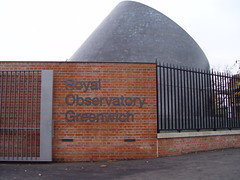Traduzione by CARLO CARADONNA, volontario di English Gratis. Il testo originale è tratto da una pagina del sito inglese di Wikipedia ed è disponibile nel rispetto della licenza Creative Commons Attribution 2.5
![]() photo credit: DavidQuick
photo credit: DavidQuick
Royal Observatory, Greenwich (1)
Osservatorio reale, Greenwich (1)
Vai alla puntata: 1–2–3–4
The Royal Observatory, Greenwich (formerly the Royal Greenwich Observatory or RGO) was commissioned in 1675 by King Charles II, with the foundation stone being laid on 10 August.
L’osservatorio reale, Greenwich ( precedentemente il “Royal Greenwich Observatory” o RGO) fu commissionato nel 1675 dal re Carlo II; la prima pietra fu posta il 10 agosto (dello stesso anno).
At this time the king also created the position of Astronomer Royal (initially filled by John Flamsteed), to serve as the director of the observatory and to “apply himself with the most exact care and diligence to the rectifying of the tables of the motions of the heavens, and the places of the fixed stars, so as to find out the so much desired longitude of places for the perfecting of the art of navigation”.
In quel tempo il re istituì anche la posizione di Astronomo Reale ( inizialmente ricoperta da John Flamsteed ), per prestare la propria opera come direttore dell’osservatorio e per “applicarsi con la massima attenzione e cura secondo dei criteri di estrema precisione alla rettifica delle tavole dei moti dei corpi celesti e dei punti delle stelle fisse, cosi’ da scoprire la tanto desiderata longitudine dei luoghi per portare a un livello di perfezione l’arte della navigazione”.
It is situated on a hill in Greenwich Park in Greenwich, London, overlooking the River Thames.
L’Osservatorio è situato su una collina all’interno del Greenwich Park, a Londra, in una posizione che domina dall’alto il fiume Tamigi.
History
Storia
Flamsteed House, the original part of the Observatory, was designed by Sir Christopher Wren probably with the assistance of Robert Hooke and was the first purpose-built scientific research facility in Britain.
La Flamsteed House, la parte originaria dell’Osservatorio, fu progettata da Sir Christopher Wren, probabilmente con l’assistenza di Robert Hook e fu la prima struttura appositamente realizzata per la ricerca scientifica nel territorio Britannico.
It was built for a cost of £ 520 (£ 20 over budget) out of largely recycled materials on the foundations of Duke Humphrey’s Tower, which resulted in the alignment being 13 degrees away from true North, somewhat to Flamsteed’s chagrin.
(L’edificio) fu costruito ad un costo di 520 sterline ( 20 sterline oltre il costo preventivato) con materiali in larga misura riciclati sulle fondamenta della Torre del Duca Humphrey , che risulto’ trovarsi nell’allineamento a 13 gradi di distanza dal vero Nord, con un certo rammarico dello stesso Flamsteed.
It housed not only the scientific instruments to be used by Flamsteed in his work on stellar tables, but over time also incorporated a number of additional responsibilities such as the keeping of time and later Her Majesty’s Nautical Almanac Office.
(L’edificio) non soltanto fu depositario della strumentazione scientifica necessaria per Flamsteed nel suo lavoro sui cataloghi stellari, ma nel tempo assunse anche diverse ulteriori incombenze come la registrazione del tempo e in seguito la gestione dell’Ufficio dell’Almanacco Nautico di sua Maestà.
Two clocks, built by Thomas Tompion, were installed in the 20 foot high Octagon Room, the principal room of the building.
Due orologi, realizzati da Thomas Tompion, furono installati nella sala ottagonale (Octagon Room) alta 6,096 metri (20 piedi), la sala principale dell’edificio.
They were of unusual design, each with a pendulum 13 feet (3.96 metres) in length mounted above the clock face, giving a period of four seconds and an accuracy, then unparalleled, of seven seconds per day.
Essi furono fuori dal comune per quanto attiene il loro modello; entrambi con un pendolo lungo
3,96 metri (13 piedi) montato al di sopra del quadrante, segnando un intervallo di quattro secondi e fornendo una precisione (nella misurazione del tempo) di 7 secondi al giorno, allora senza precedenti.
(continua)



